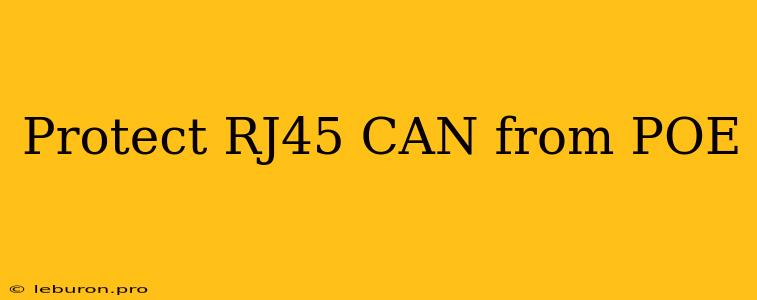The robust nature of RJ45 connectors makes them a prevalent choice for networking applications. However, the integration of Power over Ethernet (PoE) technology introduces a potential risk for sensitive electronics connected via RJ45, such as Controller Area Network (CAN) devices. This is because PoE injects high voltage into the RJ45 port, which can potentially damage the delicate circuitry within CAN devices. This article will delve into the crucial need for protection mechanisms to safeguard RJ45 CAN connections from PoE-induced hazards.
The Threat of PoE to RJ45 CAN
PoE, a technology that transmits both data and power over Ethernet cables, has become increasingly popular for powering devices in various settings like industrial environments, building automation, and smart homes. While this approach offers convenience and flexibility, it also presents a significant risk for RJ45 CAN interfaces.
CAN, a communication protocol commonly employed in automotive, industrial, and other embedded systems, is known for its real-time capabilities and high reliability. However, CAN transceivers and other components within CAN devices are designed to operate at low voltage levels. The presence of high PoE voltage on the RJ45 connector can lead to several adverse consequences:
- Circuitry Damage: The high voltage injected by PoE can damage the delicate circuitry within CAN devices, leading to malfunctions, permanent damage, and even system failures.
- Data Corruption: The sudden surge in voltage can interfere with data transmission, causing errors, communication disruptions, and unreliable data flow.
- System Instability: The presence of high voltage can destabilize the entire system, leading to unexpected behavior, unpredictable performance, and potential safety risks.
The Need for Protection
The potential risks posed by PoE to RJ45 CAN devices highlight the importance of implementing robust protection mechanisms. These measures are crucial to mitigate the dangers associated with PoE voltage and ensure the integrity and reliability of CAN communications.
Protection Strategies
Several strategies can be employed to effectively protect RJ45 CAN devices from PoE voltage:
1. PoE Isolation
One of the most effective approaches is to physically isolate the PoE voltage from the RJ45 CAN connector. This can be achieved using a variety of methods:
- PoE Isolators: These devices are specifically designed to block high voltage while allowing data signals to pass through. PoE isolators typically incorporate components such as transformers or capacitors that act as barriers to prevent the flow of high voltage into the CAN device.
- Passive Filters: Passive filters can be implemented on the RJ45 connector to filter out the high voltage frequencies associated with PoE. These filters typically consist of capacitors and inductors that block the high voltage signals while allowing the data signals to pass through.
- Diode Protection: Using diodes in the RJ45 connector can effectively prevent the flow of high voltage into the CAN device. Diodes act as one-way valves, allowing the flow of data signals in one direction while blocking the flow of high voltage in the opposite direction.
2. Voltage Regulation
Voltage regulators are electronic components that can effectively reduce high voltage levels to safe operating levels for CAN devices. They work by converting the high PoE voltage into a lower voltage suitable for the CAN device's circuitry. Voltage regulators can be implemented either as dedicated components or integrated within the device's design.
3. Overvoltage Protection
Overvoltage protection circuits are essential components that protect CAN devices from voltage spikes and surges. These circuits are typically designed to shunt excess voltage to ground, preventing it from damaging the sensitive circuitry within the device.
4. Design Considerations
When designing RJ45 CAN interfaces, it's essential to incorporate the following considerations to enhance protection:
- Choosing Components: Select components that are specifically designed for high voltage applications and are robust enough to withstand the potential hazards of PoE voltage.
- Layering Protection: Combine multiple protection techniques to create a multi-layered defense mechanism against PoE voltage.
- Testing and Verification: Thoroughly test the design to ensure that the implemented protection mechanisms effectively safeguard the RJ45 CAN interface from PoE voltage.
Conclusion
Protecting RJ45 CAN interfaces from PoE voltage is crucial to ensuring the integrity and reliability of sensitive electronics. By implementing robust protection strategies, such as PoE isolation, voltage regulation, overvoltage protection, and careful design considerations, designers can effectively mitigate the risks posed by PoE and safeguard the performance and longevity of their systems. This will enable the continued use of RJ45 CAN interfaces in various applications where PoE technology is employed, ensuring seamless communication and reliable operation.
